SHR044-6: Mobilising Creativity and Innovation - Individual Skills
VerifiedAdded on 2023/06/12
|9
|2101
|390
Report
AI Summary
This report explores the importance of mobilising creativity and innovation, focusing on individual creative thinking skills within an organisational context. It delves into creative problem-solving methodologies, such as the Osborn-Parnes model, and highlights opportunities gained through fostering organisational creativity and innovation, including competitive advantage, improved communication, and increased staff morale. The report also addresses challenges like rigid organisational structures and fear of punishment that can hinder creative thinking. Recommendations are provided to cultivate a creative environment through continuous skill improvement, encouragement of unconventional views, and proactive management initiatives. Ultimately, the report advocates for a holistic approach to promoting creativity and innovation, emphasising implementation of ideas to achieve tangible results. Desklib provides a platform to access this and similar solved assignments.
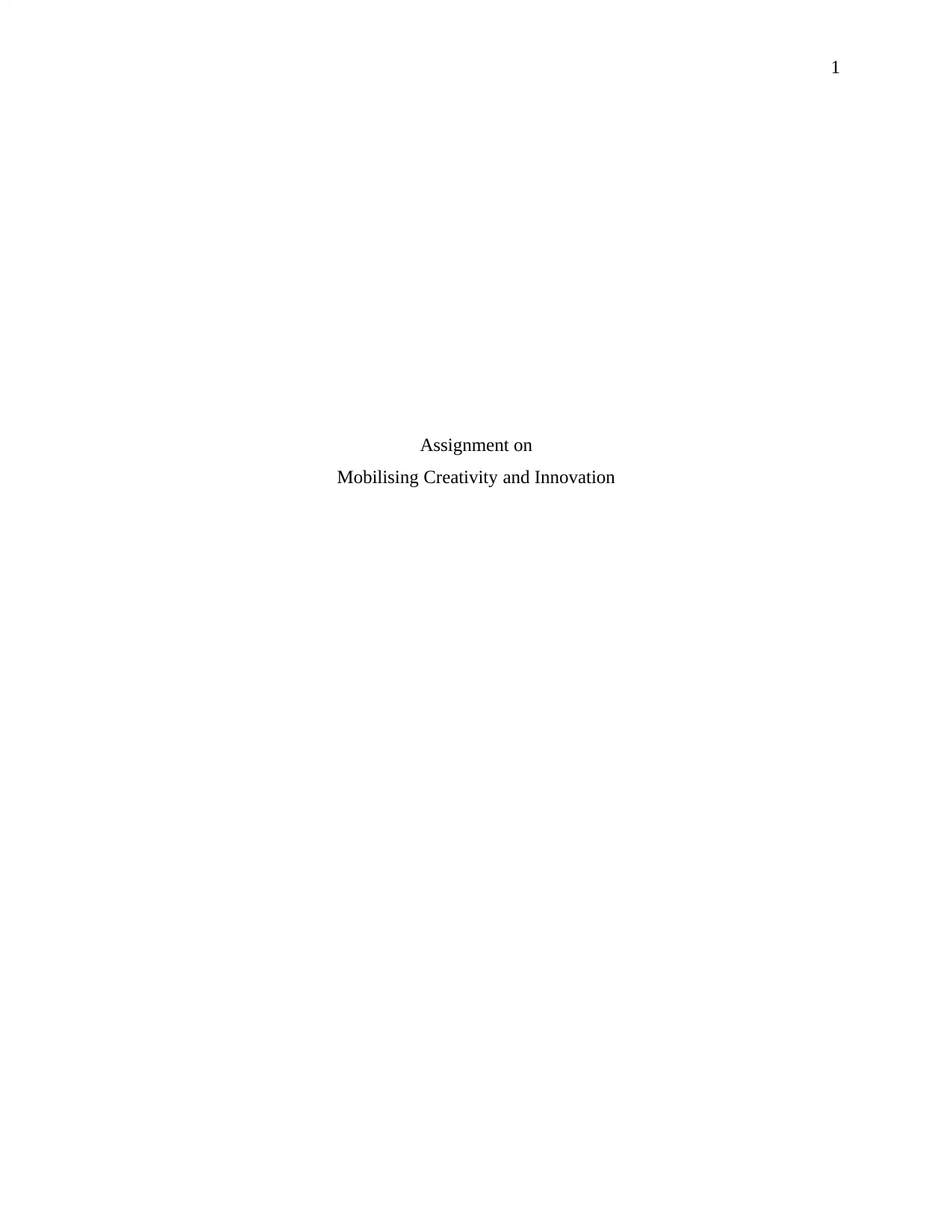
1
Assignment on
Mobilising Creativity and Innovation
Assignment on
Mobilising Creativity and Innovation
Paraphrase This Document
Need a fresh take? Get an instant paraphrase of this document with our AI Paraphraser

2
Table of Contents
Introduction......................................................................................................................................3
Creative Problem Solving................................................................................................................3
Opportunities in promoting organisational creativity and innovation.............................................4
Challenges in promoting organisational creativity and innovation.................................................6
Conclusion.......................................................................................................................................6
Recommendations............................................................................................................................7
References........................................................................................................................................8
Table of Contents
Introduction......................................................................................................................................3
Creative Problem Solving................................................................................................................3
Opportunities in promoting organisational creativity and innovation.............................................4
Challenges in promoting organisational creativity and innovation.................................................6
Conclusion.......................................................................................................................................6
Recommendations............................................................................................................................7
References........................................................................................................................................8
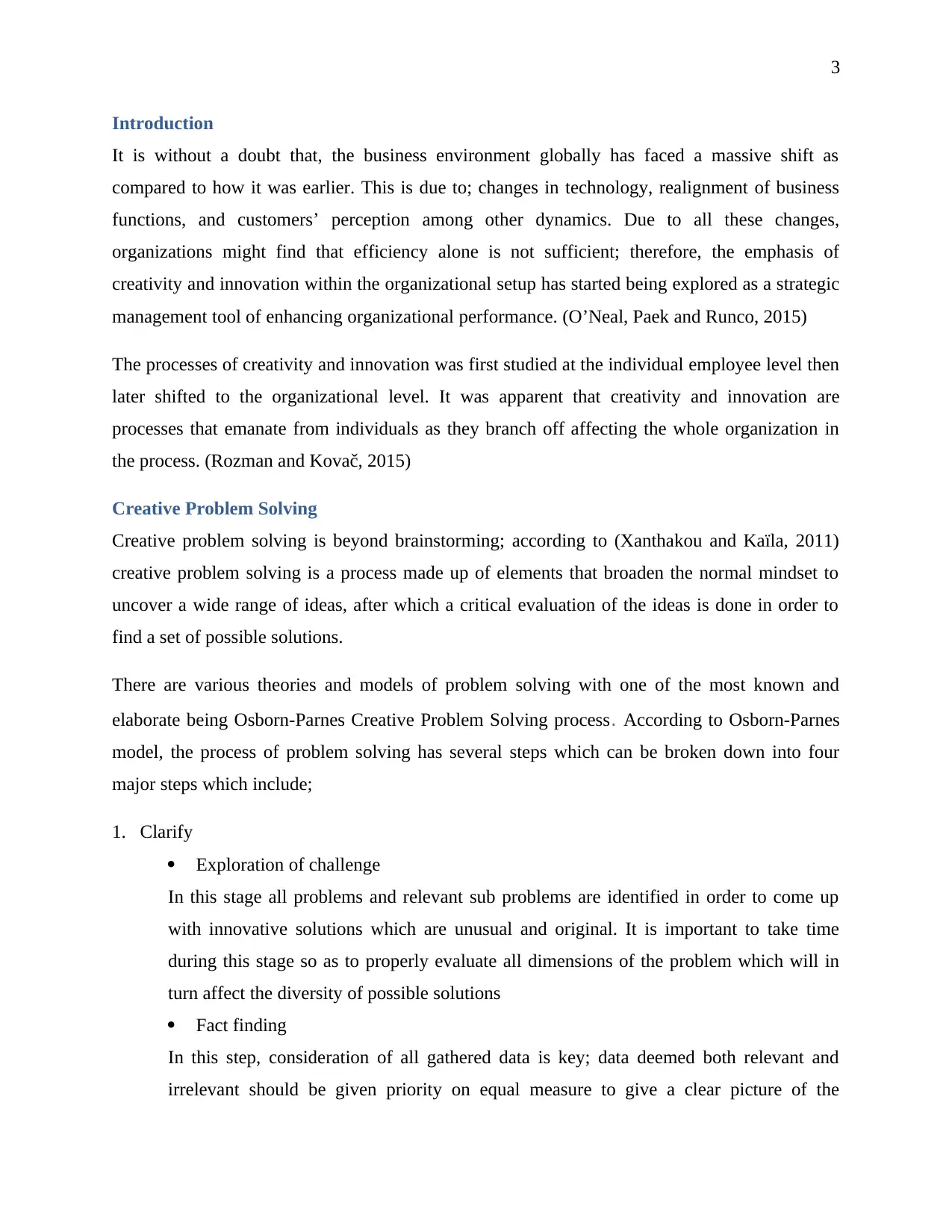
3
Introduction
It is without a doubt that, the business environment globally has faced a massive shift as
compared to how it was earlier. This is due to; changes in technology, realignment of business
functions, and customers’ perception among other dynamics. Due to all these changes,
organizations might find that efficiency alone is not sufficient; therefore, the emphasis of
creativity and innovation within the organizational setup has started being explored as a strategic
management tool of enhancing organizational performance. (O’Neal, Paek and Runco, 2015)
The processes of creativity and innovation was first studied at the individual employee level then
later shifted to the organizational level. It was apparent that creativity and innovation are
processes that emanate from individuals as they branch off affecting the whole organization in
the process. (Rozman and Kovač, 2015)
Creative Problem Solving
Creative problem solving is beyond brainstorming; according to (Xanthakou and Kaïla, 2011)
creative problem solving is a process made up of elements that broaden the normal mindset to
uncover a wide range of ideas, after which a critical evaluation of the ideas is done in order to
find a set of possible solutions.
There are various theories and models of problem solving with one of the most known and
elaborate being Osborn-Parnes Creative Problem Solving process. According to Osborn-Parnes
model, the process of problem solving has several steps which can be broken down into four
major steps which include;
1. Clarify
Exploration of challenge
In this stage all problems and relevant sub problems are identified in order to come up
with innovative solutions which are unusual and original. It is important to take time
during this stage so as to properly evaluate all dimensions of the problem which will in
turn affect the diversity of possible solutions
Fact finding
In this step, consideration of all gathered data is key; data deemed both relevant and
irrelevant should be given priority on equal measure to give a clear picture of the
Introduction
It is without a doubt that, the business environment globally has faced a massive shift as
compared to how it was earlier. This is due to; changes in technology, realignment of business
functions, and customers’ perception among other dynamics. Due to all these changes,
organizations might find that efficiency alone is not sufficient; therefore, the emphasis of
creativity and innovation within the organizational setup has started being explored as a strategic
management tool of enhancing organizational performance. (O’Neal, Paek and Runco, 2015)
The processes of creativity and innovation was first studied at the individual employee level then
later shifted to the organizational level. It was apparent that creativity and innovation are
processes that emanate from individuals as they branch off affecting the whole organization in
the process. (Rozman and Kovač, 2015)
Creative Problem Solving
Creative problem solving is beyond brainstorming; according to (Xanthakou and Kaïla, 2011)
creative problem solving is a process made up of elements that broaden the normal mindset to
uncover a wide range of ideas, after which a critical evaluation of the ideas is done in order to
find a set of possible solutions.
There are various theories and models of problem solving with one of the most known and
elaborate being Osborn-Parnes Creative Problem Solving process. According to Osborn-Parnes
model, the process of problem solving has several steps which can be broken down into four
major steps which include;
1. Clarify
Exploration of challenge
In this stage all problems and relevant sub problems are identified in order to come up
with innovative solutions which are unusual and original. It is important to take time
during this stage so as to properly evaluate all dimensions of the problem which will in
turn affect the diversity of possible solutions
Fact finding
In this step, consideration of all gathered data is key; data deemed both relevant and
irrelevant should be given priority on equal measure to give a clear picture of the
⊘ This is a preview!⊘
Do you want full access?
Subscribe today to unlock all pages.

Trusted by 1+ million students worldwide
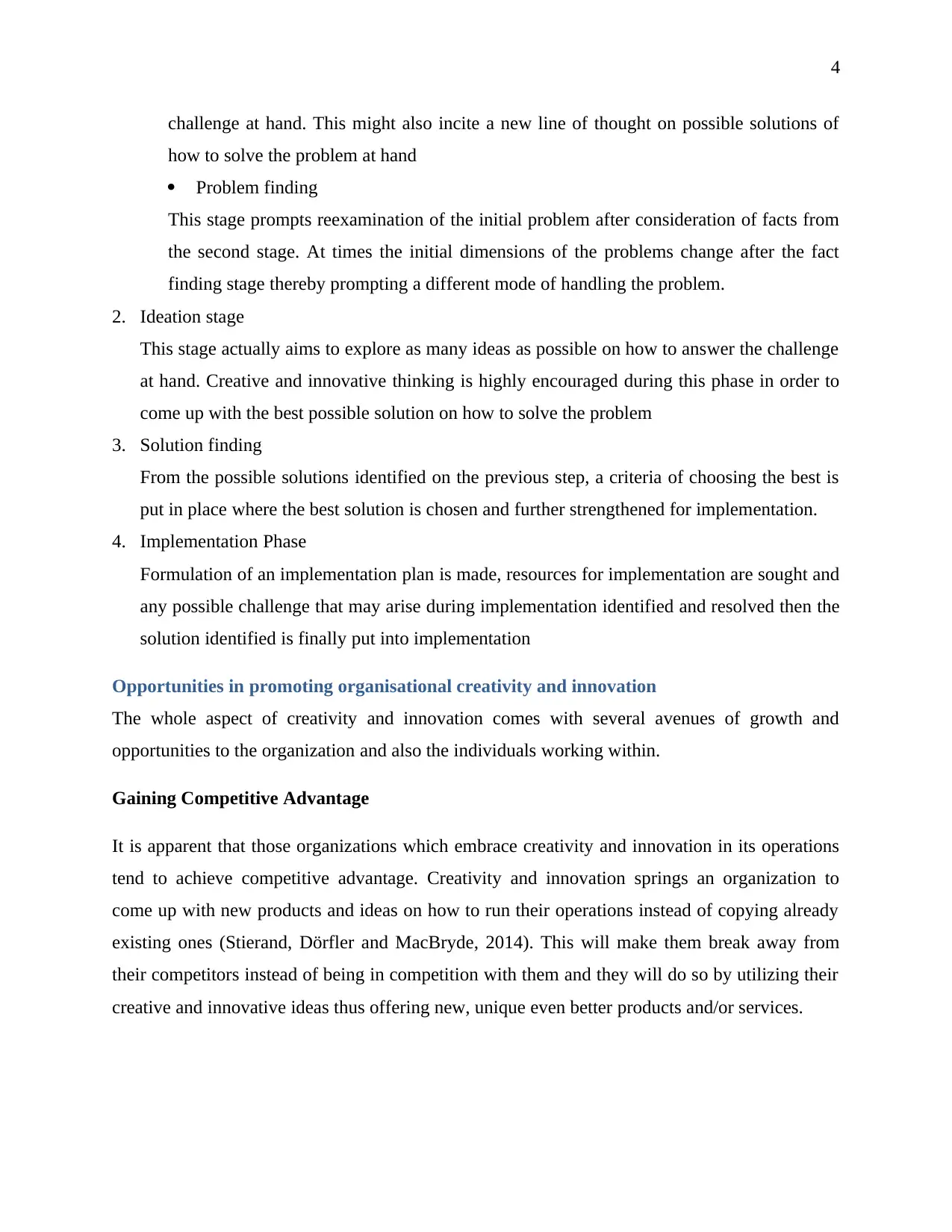
4
challenge at hand. This might also incite a new line of thought on possible solutions of
how to solve the problem at hand
Problem finding
This stage prompts reexamination of the initial problem after consideration of facts from
the second stage. At times the initial dimensions of the problems change after the fact
finding stage thereby prompting a different mode of handling the problem.
2. Ideation stage
This stage actually aims to explore as many ideas as possible on how to answer the challenge
at hand. Creative and innovative thinking is highly encouraged during this phase in order to
come up with the best possible solution on how to solve the problem
3. Solution finding
From the possible solutions identified on the previous step, a criteria of choosing the best is
put in place where the best solution is chosen and further strengthened for implementation.
4. Implementation Phase
Formulation of an implementation plan is made, resources for implementation are sought and
any possible challenge that may arise during implementation identified and resolved then the
solution identified is finally put into implementation
Opportunities in promoting organisational creativity and innovation
The whole aspect of creativity and innovation comes with several avenues of growth and
opportunities to the organization and also the individuals working within.
Gaining Competitive Advantage
It is apparent that those organizations which embrace creativity and innovation in its operations
tend to achieve competitive advantage. Creativity and innovation springs an organization to
come up with new products and ideas on how to run their operations instead of copying already
existing ones (Stierand, Dörfler and MacBryde, 2014). This will make them break away from
their competitors instead of being in competition with them and they will do so by utilizing their
creative and innovative ideas thus offering new, unique even better products and/or services.
challenge at hand. This might also incite a new line of thought on possible solutions of
how to solve the problem at hand
Problem finding
This stage prompts reexamination of the initial problem after consideration of facts from
the second stage. At times the initial dimensions of the problems change after the fact
finding stage thereby prompting a different mode of handling the problem.
2. Ideation stage
This stage actually aims to explore as many ideas as possible on how to answer the challenge
at hand. Creative and innovative thinking is highly encouraged during this phase in order to
come up with the best possible solution on how to solve the problem
3. Solution finding
From the possible solutions identified on the previous step, a criteria of choosing the best is
put in place where the best solution is chosen and further strengthened for implementation.
4. Implementation Phase
Formulation of an implementation plan is made, resources for implementation are sought and
any possible challenge that may arise during implementation identified and resolved then the
solution identified is finally put into implementation
Opportunities in promoting organisational creativity and innovation
The whole aspect of creativity and innovation comes with several avenues of growth and
opportunities to the organization and also the individuals working within.
Gaining Competitive Advantage
It is apparent that those organizations which embrace creativity and innovation in its operations
tend to achieve competitive advantage. Creativity and innovation springs an organization to
come up with new products and ideas on how to run their operations instead of copying already
existing ones (Stierand, Dörfler and MacBryde, 2014). This will make them break away from
their competitors instead of being in competition with them and they will do so by utilizing their
creative and innovative ideas thus offering new, unique even better products and/or services.
Paraphrase This Document
Need a fresh take? Get an instant paraphrase of this document with our AI Paraphraser
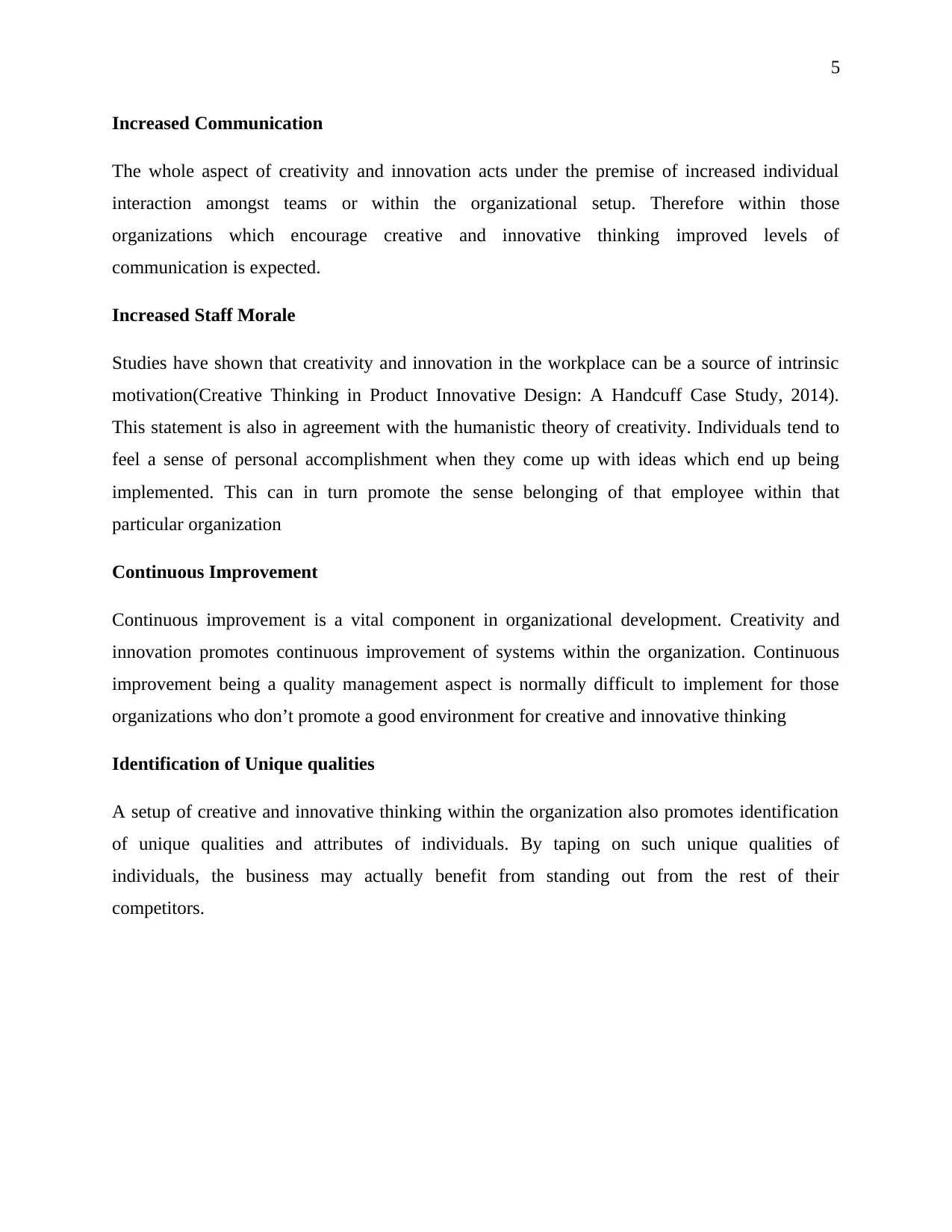
5
Increased Communication
The whole aspect of creativity and innovation acts under the premise of increased individual
interaction amongst teams or within the organizational setup. Therefore within those
organizations which encourage creative and innovative thinking improved levels of
communication is expected.
Increased Staff Morale
Studies have shown that creativity and innovation in the workplace can be a source of intrinsic
motivation(Creative Thinking in Product Innovative Design: A Handcuff Case Study, 2014).
This statement is also in agreement with the humanistic theory of creativity. Individuals tend to
feel a sense of personal accomplishment when they come up with ideas which end up being
implemented. This can in turn promote the sense belonging of that employee within that
particular organization
Continuous Improvement
Continuous improvement is a vital component in organizational development. Creativity and
innovation promotes continuous improvement of systems within the organization. Continuous
improvement being a quality management aspect is normally difficult to implement for those
organizations who don’t promote a good environment for creative and innovative thinking
Identification of Unique qualities
A setup of creative and innovative thinking within the organization also promotes identification
of unique qualities and attributes of individuals. By taping on such unique qualities of
individuals, the business may actually benefit from standing out from the rest of their
competitors.
Increased Communication
The whole aspect of creativity and innovation acts under the premise of increased individual
interaction amongst teams or within the organizational setup. Therefore within those
organizations which encourage creative and innovative thinking improved levels of
communication is expected.
Increased Staff Morale
Studies have shown that creativity and innovation in the workplace can be a source of intrinsic
motivation(Creative Thinking in Product Innovative Design: A Handcuff Case Study, 2014).
This statement is also in agreement with the humanistic theory of creativity. Individuals tend to
feel a sense of personal accomplishment when they come up with ideas which end up being
implemented. This can in turn promote the sense belonging of that employee within that
particular organization
Continuous Improvement
Continuous improvement is a vital component in organizational development. Creativity and
innovation promotes continuous improvement of systems within the organization. Continuous
improvement being a quality management aspect is normally difficult to implement for those
organizations who don’t promote a good environment for creative and innovative thinking
Identification of Unique qualities
A setup of creative and innovative thinking within the organization also promotes identification
of unique qualities and attributes of individuals. By taping on such unique qualities of
individuals, the business may actually benefit from standing out from the rest of their
competitors.
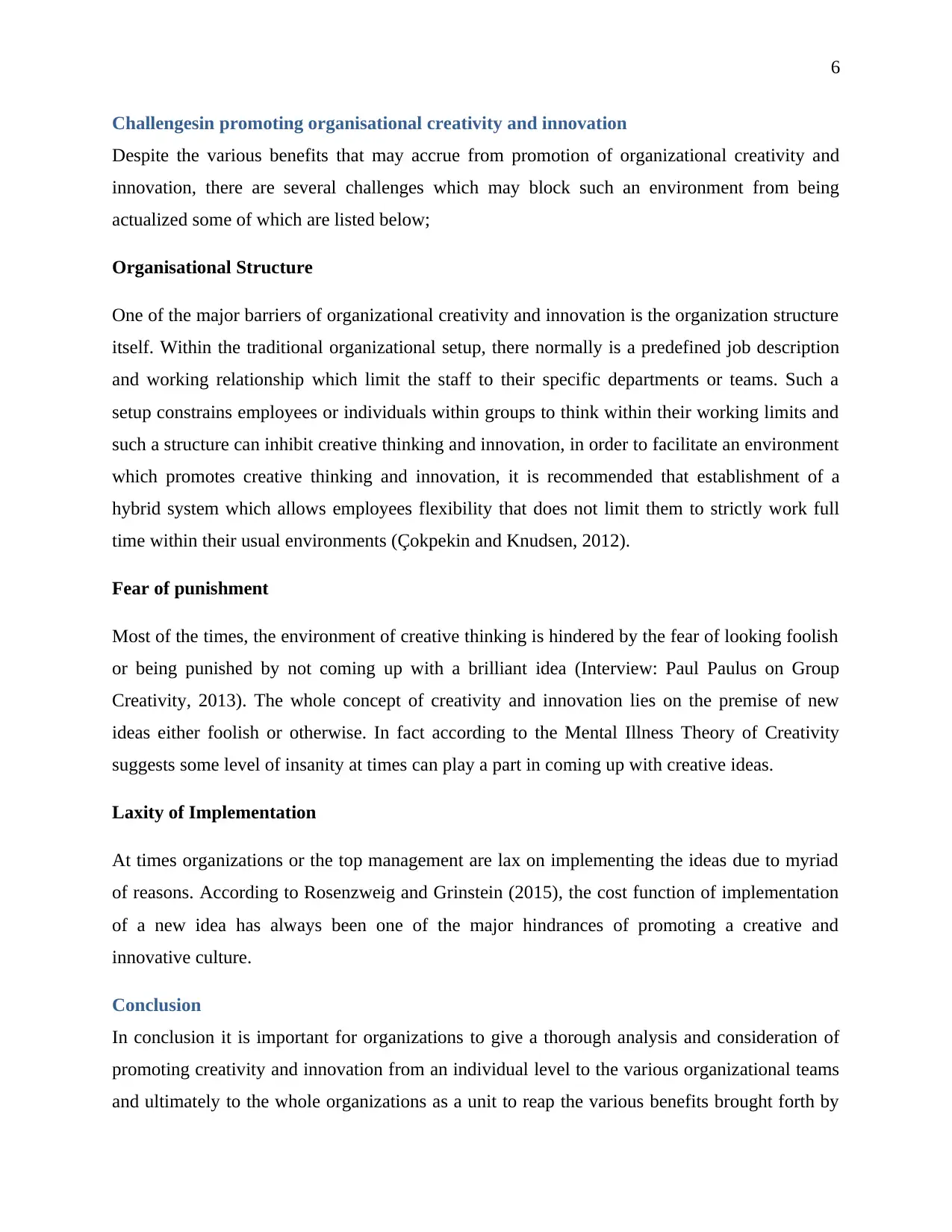
6
Challengesin promoting organisational creativity and innovation
Despite the various benefits that may accrue from promotion of organizational creativity and
innovation, there are several challenges which may block such an environment from being
actualized some of which are listed below;
Organisational Structure
One of the major barriers of organizational creativity and innovation is the organization structure
itself. Within the traditional organizational setup, there normally is a predefined job description
and working relationship which limit the staff to their specific departments or teams. Such a
setup constrains employees or individuals within groups to think within their working limits and
such a structure can inhibit creative thinking and innovation, in order to facilitate an environment
which promotes creative thinking and innovation, it is recommended that establishment of a
hybrid system which allows employees flexibility that does not limit them to strictly work full
time within their usual environments (Çokpekin and Knudsen, 2012).
Fear of punishment
Most of the times, the environment of creative thinking is hindered by the fear of looking foolish
or being punished by not coming up with a brilliant idea (Interview: Paul Paulus on Group
Creativity, 2013). The whole concept of creativity and innovation lies on the premise of new
ideas either foolish or otherwise. In fact according to the Mental Illness Theory of Creativity
suggests some level of insanity at times can play a part in coming up with creative ideas.
Laxity of Implementation
At times organizations or the top management are lax on implementing the ideas due to myriad
of reasons. According to Rosenzweig and Grinstein (2015), the cost function of implementation
of a new idea has always been one of the major hindrances of promoting a creative and
innovative culture.
Conclusion
In conclusion it is important for organizations to give a thorough analysis and consideration of
promoting creativity and innovation from an individual level to the various organizational teams
and ultimately to the whole organizations as a unit to reap the various benefits brought forth by
Challengesin promoting organisational creativity and innovation
Despite the various benefits that may accrue from promotion of organizational creativity and
innovation, there are several challenges which may block such an environment from being
actualized some of which are listed below;
Organisational Structure
One of the major barriers of organizational creativity and innovation is the organization structure
itself. Within the traditional organizational setup, there normally is a predefined job description
and working relationship which limit the staff to their specific departments or teams. Such a
setup constrains employees or individuals within groups to think within their working limits and
such a structure can inhibit creative thinking and innovation, in order to facilitate an environment
which promotes creative thinking and innovation, it is recommended that establishment of a
hybrid system which allows employees flexibility that does not limit them to strictly work full
time within their usual environments (Çokpekin and Knudsen, 2012).
Fear of punishment
Most of the times, the environment of creative thinking is hindered by the fear of looking foolish
or being punished by not coming up with a brilliant idea (Interview: Paul Paulus on Group
Creativity, 2013). The whole concept of creativity and innovation lies on the premise of new
ideas either foolish or otherwise. In fact according to the Mental Illness Theory of Creativity
suggests some level of insanity at times can play a part in coming up with creative ideas.
Laxity of Implementation
At times organizations or the top management are lax on implementing the ideas due to myriad
of reasons. According to Rosenzweig and Grinstein (2015), the cost function of implementation
of a new idea has always been one of the major hindrances of promoting a creative and
innovative culture.
Conclusion
In conclusion it is important for organizations to give a thorough analysis and consideration of
promoting creativity and innovation from an individual level to the various organizational teams
and ultimately to the whole organizations as a unit to reap the various benefits brought forth by
⊘ This is a preview!⊘
Do you want full access?
Subscribe today to unlock all pages.

Trusted by 1+ million students worldwide
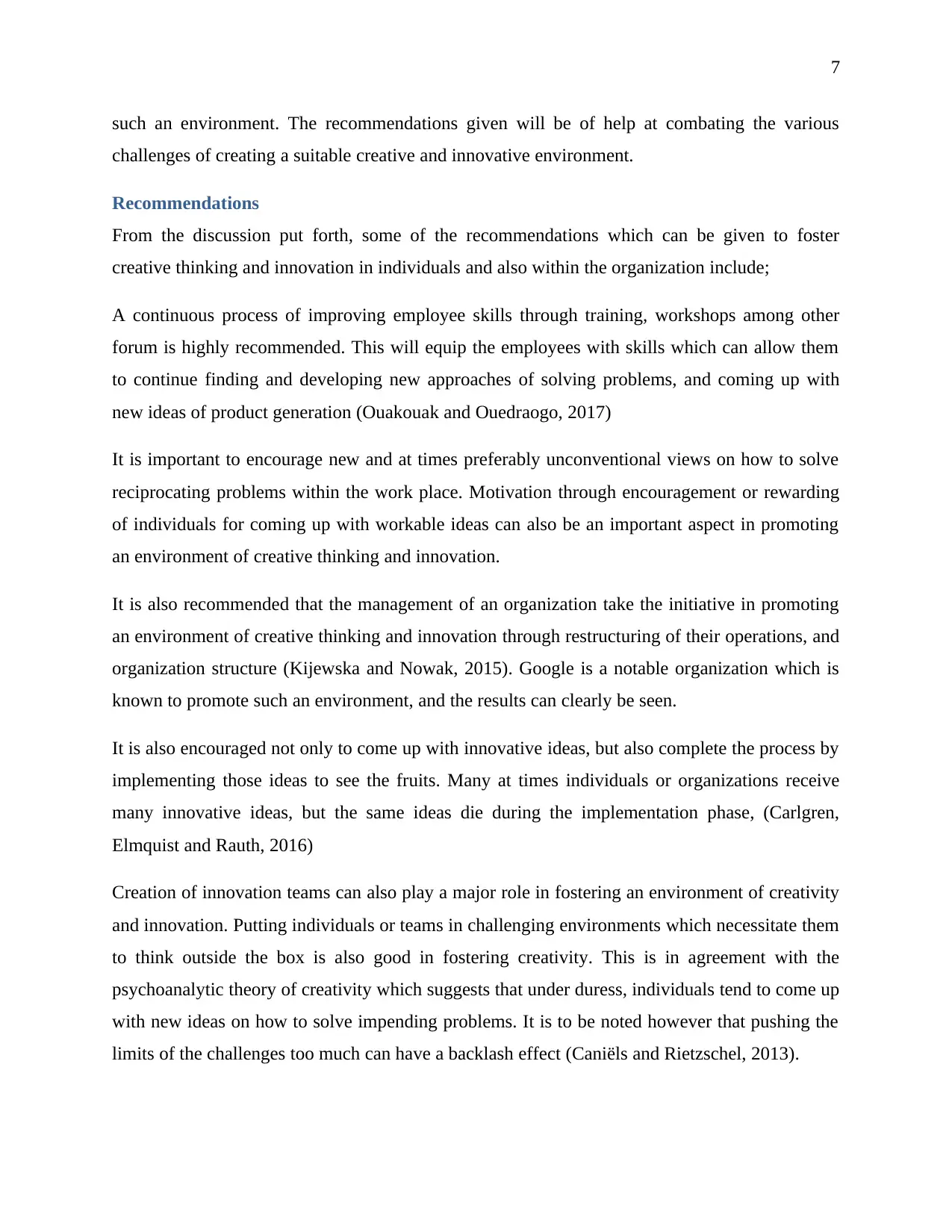
7
such an environment. The recommendations given will be of help at combating the various
challenges of creating a suitable creative and innovative environment.
Recommendations
From the discussion put forth, some of the recommendations which can be given to foster
creative thinking and innovation in individuals and also within the organization include;
A continuous process of improving employee skills through training, workshops among other
forum is highly recommended. This will equip the employees with skills which can allow them
to continue finding and developing new approaches of solving problems, and coming up with
new ideas of product generation (Ouakouak and Ouedraogo, 2017)
It is important to encourage new and at times preferably unconventional views on how to solve
reciprocating problems within the work place. Motivation through encouragement or rewarding
of individuals for coming up with workable ideas can also be an important aspect in promoting
an environment of creative thinking and innovation.
It is also recommended that the management of an organization take the initiative in promoting
an environment of creative thinking and innovation through restructuring of their operations, and
organization structure (Kijewska and Nowak, 2015). Google is a notable organization which is
known to promote such an environment, and the results can clearly be seen.
It is also encouraged not only to come up with innovative ideas, but also complete the process by
implementing those ideas to see the fruits. Many at times individuals or organizations receive
many innovative ideas, but the same ideas die during the implementation phase, (Carlgren,
Elmquist and Rauth, 2016)
Creation of innovation teams can also play a major role in fostering an environment of creativity
and innovation. Putting individuals or teams in challenging environments which necessitate them
to think outside the box is also good in fostering creativity. This is in agreement with the
psychoanalytic theory of creativity which suggests that under duress, individuals tend to come up
with new ideas on how to solve impending problems. It is to be noted however that pushing the
limits of the challenges too much can have a backlash effect (Caniëls and Rietzschel, 2013).
such an environment. The recommendations given will be of help at combating the various
challenges of creating a suitable creative and innovative environment.
Recommendations
From the discussion put forth, some of the recommendations which can be given to foster
creative thinking and innovation in individuals and also within the organization include;
A continuous process of improving employee skills through training, workshops among other
forum is highly recommended. This will equip the employees with skills which can allow them
to continue finding and developing new approaches of solving problems, and coming up with
new ideas of product generation (Ouakouak and Ouedraogo, 2017)
It is important to encourage new and at times preferably unconventional views on how to solve
reciprocating problems within the work place. Motivation through encouragement or rewarding
of individuals for coming up with workable ideas can also be an important aspect in promoting
an environment of creative thinking and innovation.
It is also recommended that the management of an organization take the initiative in promoting
an environment of creative thinking and innovation through restructuring of their operations, and
organization structure (Kijewska and Nowak, 2015). Google is a notable organization which is
known to promote such an environment, and the results can clearly be seen.
It is also encouraged not only to come up with innovative ideas, but also complete the process by
implementing those ideas to see the fruits. Many at times individuals or organizations receive
many innovative ideas, but the same ideas die during the implementation phase, (Carlgren,
Elmquist and Rauth, 2016)
Creation of innovation teams can also play a major role in fostering an environment of creativity
and innovation. Putting individuals or teams in challenging environments which necessitate them
to think outside the box is also good in fostering creativity. This is in agreement with the
psychoanalytic theory of creativity which suggests that under duress, individuals tend to come up
with new ideas on how to solve impending problems. It is to be noted however that pushing the
limits of the challenges too much can have a backlash effect (Caniëls and Rietzschel, 2013).
Paraphrase This Document
Need a fresh take? Get an instant paraphrase of this document with our AI Paraphraser
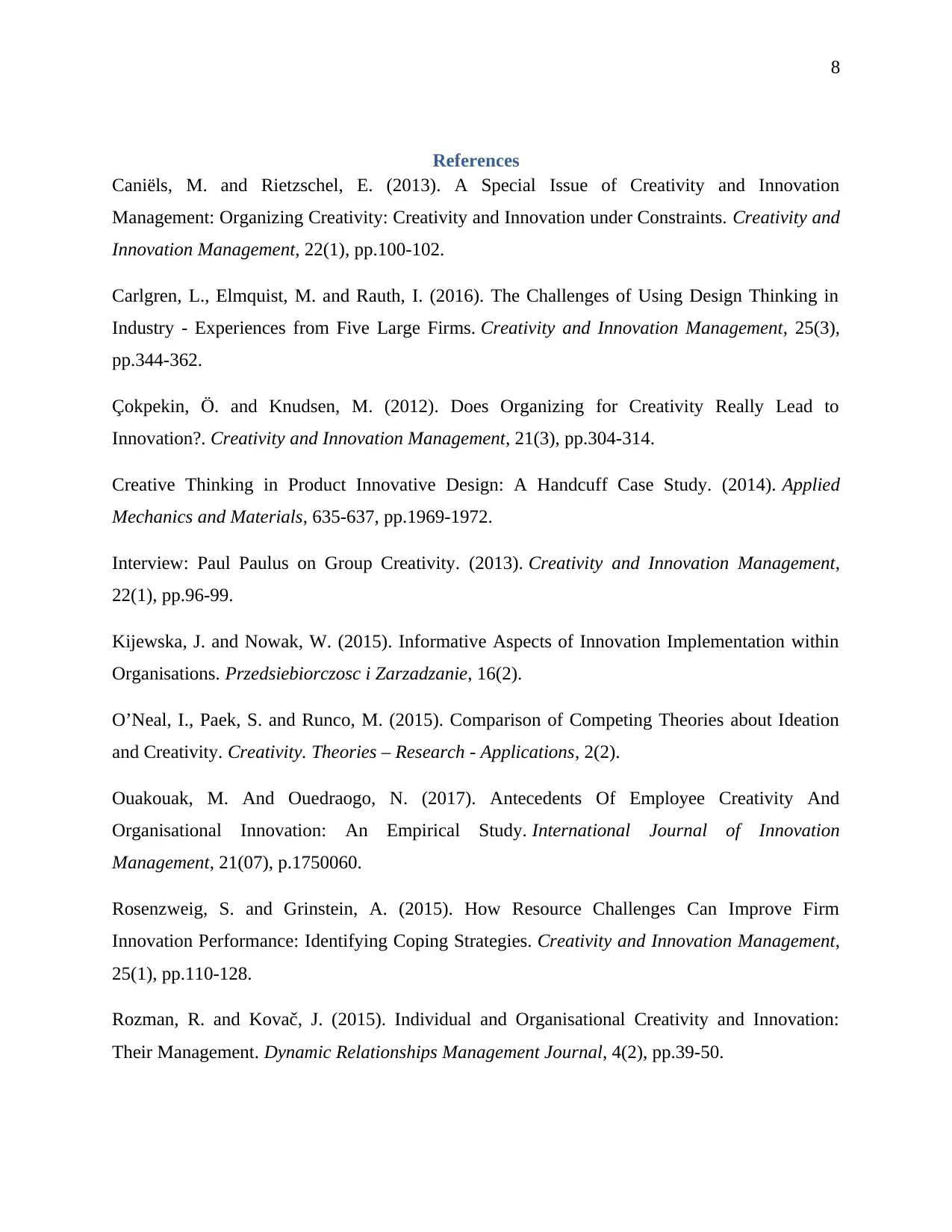
8
References
Caniëls, M. and Rietzschel, E. (2013). A Special Issue of Creativity and Innovation
Management: Organizing Creativity: Creativity and Innovation under Constraints. Creativity and
Innovation Management, 22(1), pp.100-102.
Carlgren, L., Elmquist, M. and Rauth, I. (2016). The Challenges of Using Design Thinking in
Industry - Experiences from Five Large Firms. Creativity and Innovation Management, 25(3),
pp.344-362.
Çokpekin, Ö. and Knudsen, M. (2012). Does Organizing for Creativity Really Lead to
Innovation?. Creativity and Innovation Management, 21(3), pp.304-314.
Creative Thinking in Product Innovative Design: A Handcuff Case Study. (2014). Applied
Mechanics and Materials, 635-637, pp.1969-1972.
Interview: Paul Paulus on Group Creativity. (2013). Creativity and Innovation Management,
22(1), pp.96-99.
Kijewska, J. and Nowak, W. (2015). Informative Aspects of Innovation Implementation within
Organisations. Przedsiebiorczosc i Zarzadzanie, 16(2).
O’Neal, I., Paek, S. and Runco, M. (2015). Comparison of Competing Theories about Ideation
and Creativity. Creativity. Theories – Research - Applications, 2(2).
Ouakouak, M. And Ouedraogo, N. (2017). Antecedents Of Employee Creativity And
Organisational Innovation: An Empirical Study. International Journal of Innovation
Management, 21(07), p.1750060.
Rosenzweig, S. and Grinstein, A. (2015). How Resource Challenges Can Improve Firm
Innovation Performance: Identifying Coping Strategies. Creativity and Innovation Management,
25(1), pp.110-128.
Rozman, R. and Kovač, J. (2015). Individual and Organisational Creativity and Innovation:
Their Management. Dynamic Relationships Management Journal, 4(2), pp.39-50.
References
Caniëls, M. and Rietzschel, E. (2013). A Special Issue of Creativity and Innovation
Management: Organizing Creativity: Creativity and Innovation under Constraints. Creativity and
Innovation Management, 22(1), pp.100-102.
Carlgren, L., Elmquist, M. and Rauth, I. (2016). The Challenges of Using Design Thinking in
Industry - Experiences from Five Large Firms. Creativity and Innovation Management, 25(3),
pp.344-362.
Çokpekin, Ö. and Knudsen, M. (2012). Does Organizing for Creativity Really Lead to
Innovation?. Creativity and Innovation Management, 21(3), pp.304-314.
Creative Thinking in Product Innovative Design: A Handcuff Case Study. (2014). Applied
Mechanics and Materials, 635-637, pp.1969-1972.
Interview: Paul Paulus on Group Creativity. (2013). Creativity and Innovation Management,
22(1), pp.96-99.
Kijewska, J. and Nowak, W. (2015). Informative Aspects of Innovation Implementation within
Organisations. Przedsiebiorczosc i Zarzadzanie, 16(2).
O’Neal, I., Paek, S. and Runco, M. (2015). Comparison of Competing Theories about Ideation
and Creativity. Creativity. Theories – Research - Applications, 2(2).
Ouakouak, M. And Ouedraogo, N. (2017). Antecedents Of Employee Creativity And
Organisational Innovation: An Empirical Study. International Journal of Innovation
Management, 21(07), p.1750060.
Rosenzweig, S. and Grinstein, A. (2015). How Resource Challenges Can Improve Firm
Innovation Performance: Identifying Coping Strategies. Creativity and Innovation Management,
25(1), pp.110-128.
Rozman, R. and Kovač, J. (2015). Individual and Organisational Creativity and Innovation:
Their Management. Dynamic Relationships Management Journal, 4(2), pp.39-50.

9
Stierand, M., Dörfler, V. and MacBryde, J. (2014). Creativity and Innovation in Haute Cuisine:
Towards a Systemic Model. Creativity and Innovation Management, 23(1), pp.15-28.
Xanthakou, G. and Kaïla, M. (2011). Creative problem solving. New York: Nova Science
Publishers.
Stierand, M., Dörfler, V. and MacBryde, J. (2014). Creativity and Innovation in Haute Cuisine:
Towards a Systemic Model. Creativity and Innovation Management, 23(1), pp.15-28.
Xanthakou, G. and Kaïla, M. (2011). Creative problem solving. New York: Nova Science
Publishers.
⊘ This is a preview!⊘
Do you want full access?
Subscribe today to unlock all pages.

Trusted by 1+ million students worldwide
1 out of 9
Related Documents
Your All-in-One AI-Powered Toolkit for Academic Success.
+13062052269
info@desklib.com
Available 24*7 on WhatsApp / Email
![[object Object]](/_next/static/media/star-bottom.7253800d.svg)
Unlock your academic potential
Copyright © 2020–2025 A2Z Services. All Rights Reserved. Developed and managed by ZUCOL.




